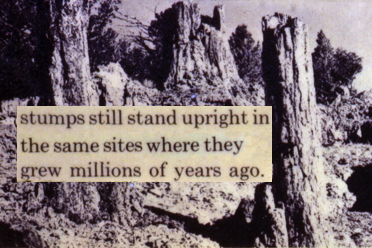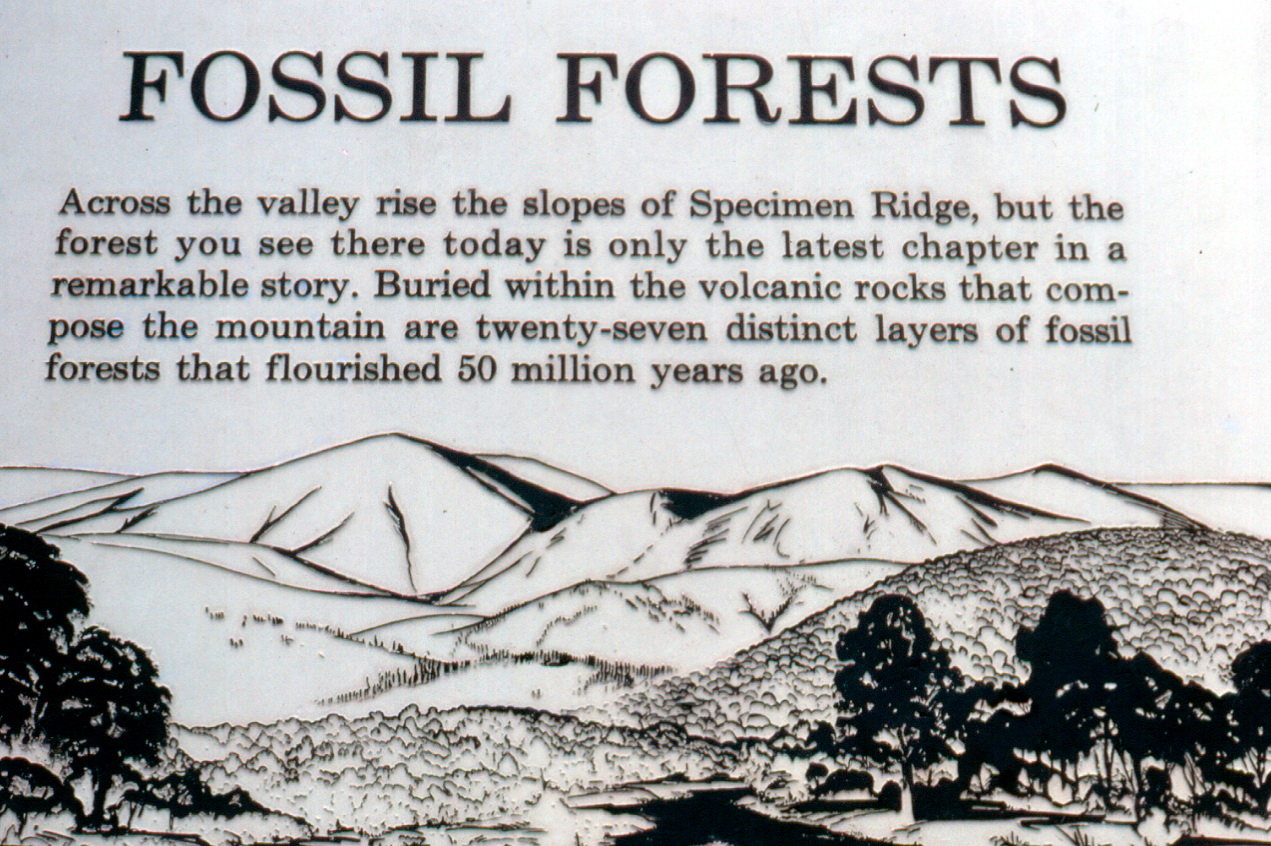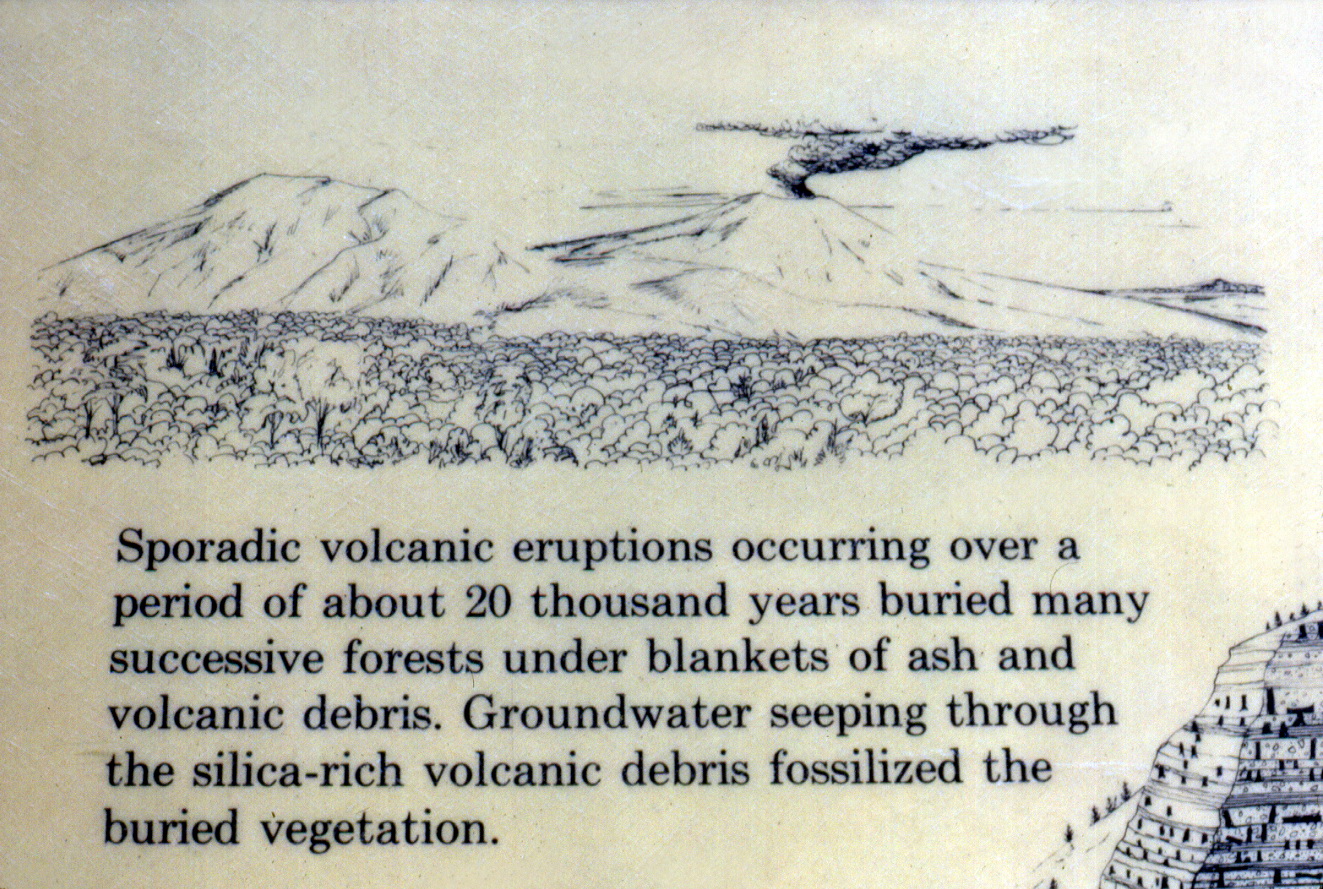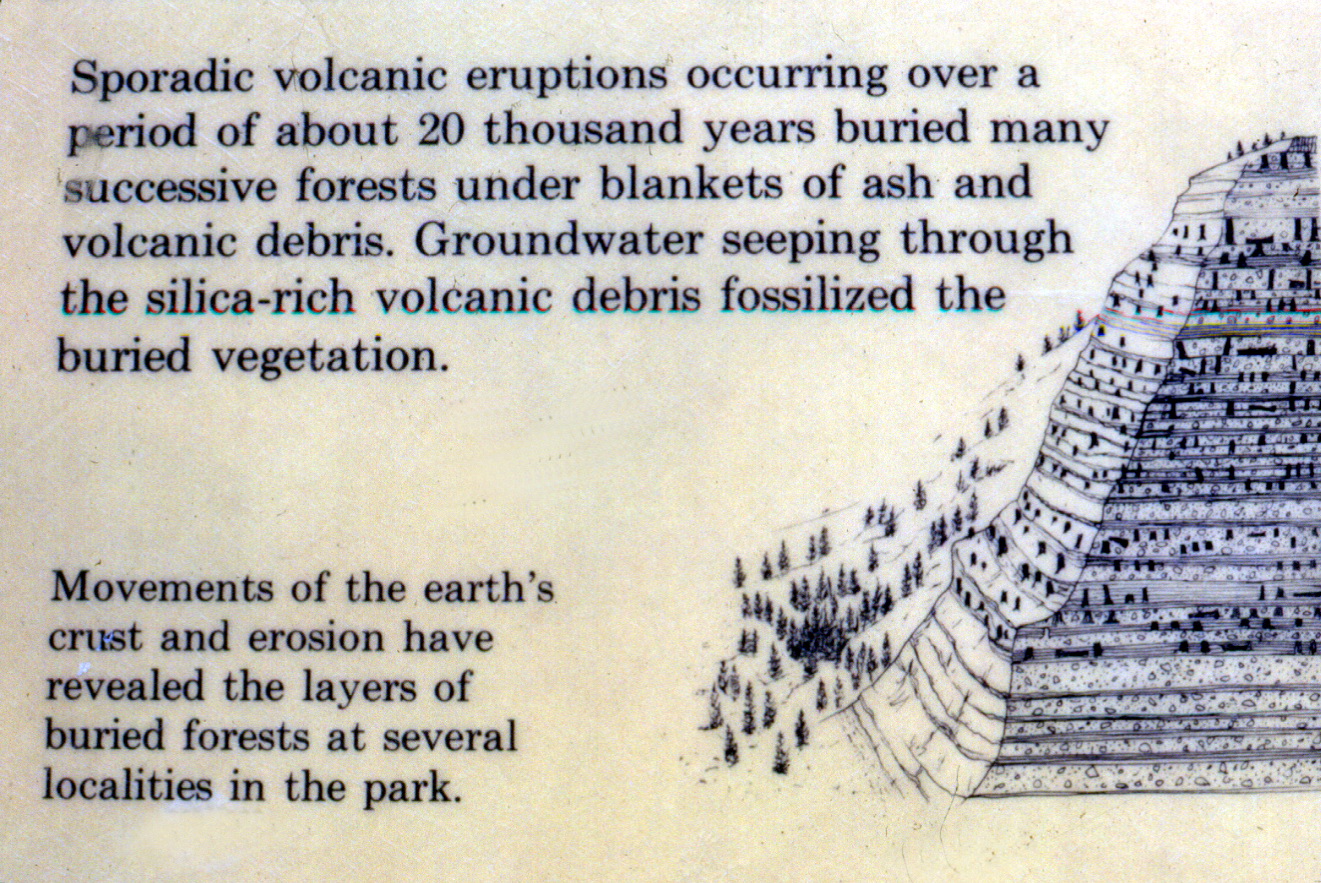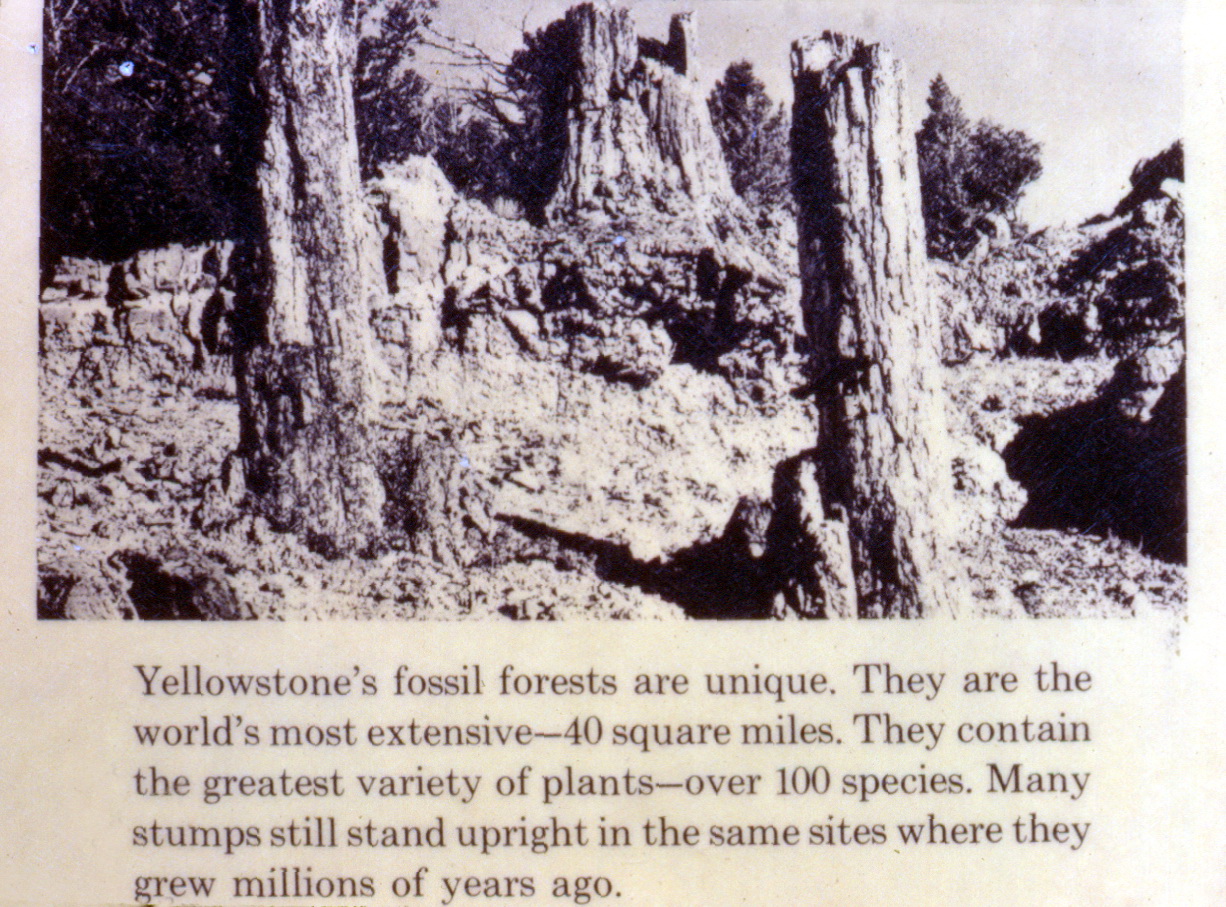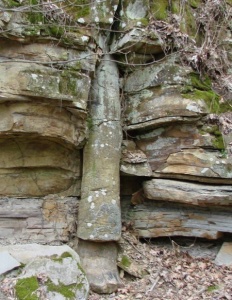 Many have heard about polystrate tree fossils, the thousands of trunks found over the last couple hundred years standing upright through multiple rock layers. (Poly means many, strata means geologic layer). Many polystrate fossils (see the list a few paragraphs down) have been buried crossing layers typically claimed to form over many thousands or even a million years. Regarding trees, areas noted for polystrate tree fossils include:
Many have heard about polystrate tree fossils, the thousands of trunks found over the last couple hundred years standing upright through multiple rock layers. (Poly means many, strata means geologic layer). Many polystrate fossils (see the list a few paragraphs down) have been buried crossing layers typically claimed to form over many thousands or even a million years. Regarding trees, areas noted for polystrate tree fossils include:
- Joggins in Nova Scotia
- Sydney, Nova Scotia (260 miles from Joggins)
- Lancashire in England
- Germany's Ruhr region
- Specimen Ridge in Yellowstone
- St. Etienne in France
- Blount County, Alabama
- Australia, Eastern U.S., etc.
Google ranks us #1 in searches for:
list of polystrate fossils.
Trees form one kind of polystrate fossil, and this list, as we will see, is not a list of polystrate tree fossils, but far more significantly, it's a list of the kinds of polystrate fossils that exist. Regarding the formation of any kind of polystrate, of course, dead organisms cannot stand for thousands of years waiting to be buried. And characteristically such fossils, as with polystrates trees, show no greater erosion at their top than at their base. So a single true polystrate fossil compresses the time it took to lay down its burial strata into a relatively brief period.
* Textbooks Skip Polystrates: Creationists claim that geology textbooks tend to omit any discussion at all of polystrate fossils. For example, a 2019 list of the top ten current geology textbooks includes Geology: A Complete Introduction. Yet a Google Books search reveals, "No results found in this book for polystrate." And there's The Changing Earth: Exploring Geology and Evolution from the worldwide publisher Thomson Learning. "No results found in this book for polystrate." Then there's Physical Geology 16th edition published by McGraw-Hill. "From inside the book, Your search - polystrate - did not match any documents." Those titles are searchable online. It appears there is a lack of interest in polystrate fossils among old-earth geologists. Just like with the greatest discovery in the history of paleontology, dinosaur soft tissue (see bflist.rsr.org), uniformitarian scientists show a lack of interest about whatever polystrate fossils can tell us about the past.
* Geologists Assigning Polystrates to Creationists: Tycho Brahe unintentionally freed astronomy from deep systemic error by assigning the study of Mars' orbit to Johann Kepler. The needed paradigm shift then happened precisely because Kepler was tenaciously curious about the planet's orbital anomalies. Regarding polystrate anomalies, evolutionary geologists lack scientific curiosity only because they assume a systematic study will not provide signficant support for their own treasured assumptions about the geologic record. Therefore, they have left the task of exploring polystrates to creationists. And explore them we will.
Enjoy the radio series: Polystrates Pt. 1, Pt. 2, & Pt. 3.
* Evolutionary Explanations for Polystrates: Even though geology textbooks ignore polystrate fossils, explanations can be found at NCSE, Wikipedia, etc. We address below all four evolutionary explanations that we've been able to identify.
EE1 Rapid Sedimentation: As an exception to the (claimed) generally slow formation of most strata, the layers that bury a polystrate are deposited during a "rapid rate of sedimentation", for example, from a river flooding and burying growing trees. (See this at NCSE, the site of Bob's opponent Eugenie Scott. This EE1 is actually the correct explanation except for two big problems presented below at CR1 in our Creationist Rebuttals.)
EE2 Persistent Trees: As at Yellowstone's Specimen Ridge it is claimed that persistent trees became petrified standing through multiple strata that were long claimed to make up 50 successive forests, vertically, each growing and dying out, one forest on top of another, fifty times. Even though the Nat'l Park Service finally removed the exhibit (see below) that makes that false claim, nonetheless it shows an inherent polystrate explanation, that trees can remain vertically long enough for the passage of sufficient geologic time to see the rise and demise of multiple strata of successive forests.
EE3 Persistent Organisms with Rapid Sedimentation: A combination of the first two explanation, with trees, for example, buried by fast sedimentation, followed by a layer of slow sedimentation. For example from Talk Origins, they suggest an initial burial in sediments of "several feet" followed by continued slower sedimentation or perhaps additional rapid sedimentation events. Trees don't die and decay instantly, so polystrate trees remained upright through a sequence of fast sedimentation followed by slow sedimentation.
EE4 Rare Enough to Ignore: Polystrate fossils are extremely rare and mostly a creationist exaggeration so they can be ignored.
* The List of Kinds of Polystrate Fossils: (see examples below)
- Upright trees form only one kind of polystrate fossil, other kinds include...
- A school of jellyfish fossilized across seven vertical layers allegedly deposited over a million-year period - Fossilized end-to-end leaves standing on edge in super-slow deposited diatoms
- Fossilized end-to-end leaves standing on edge in super-slow deposited diatoms
- A fossilized pod of whales buried across four geologic strata
- A fossilized whale buried in diatomaceous earth
- A school of tadpoles in diatoms
- Aquatic mesosaur reptile in "annual" varves
- Delicate spines radiating through layers of now sold rock
- Nautiloids in the Redwall limestone which allegedly formed at 4,000 years per inch - A fossilized school of (an allegedly) extinct trout-perch species
- A fossilized school of (an allegedly) extinct trout-perch species
- Three-dimensional trilobites in super-slowly deposited limestone
- Communities of organisms found in limestone
- Dinosaur footprints that deform multiple now rock-hard layers
- Etc. (the millions of fossils that cross strata boundaries or extend vertically through allegedly super-slowly formed rock)
* Creationist Rebuttals: The old-earth explanations are absurd on their face. Typically, they can't explain a single polystrate let alone the many different kinds of polystrate fossils and the millions of those in existence.
CR1 to Rapid Sedimentation: Even if the earth were billions of years old, secular geologists show an astounding lack of curiosity about polystrates, and by them, which strata could be shown to have been deposited rapidly. Regarding the first evolutionary explanation for polystrates, an enormous problems with EE1 is that  rapid strata formation is not the exception but the rule. Consider for example (as with the coal seams and other rock layers pictured to the right from Carbon, Utah) the characteristic worldwide lack of erosion between flat-gap parallel strata. (See rsr.org/ps.) Erosion is relentless. (Even the seafloor has long been known to change, not only from subsidence and isostatic rebound but even from a single storm, and this would be especially significant for the "shallow seas" constantly referenced in the stories of fossil deposition. Recent study shows however that the "seafloor is eroding faster than scientists thought", with Biogeosciences, for example, reporting the surprise that around Maui, "81 million cubic meters" has quickly eroded. Even for lakes, "The bathymetry of... lakes is constantly reworking".) Therefore, slow deposition rates would almost exclusively produce irregular strata boundaries rather than the millions of square miles of characteristic parallel flat gaps. The second problem with EE1 is that evolutionary geologists refuse then to follow the layers that they admit are "rapidly deposited" to see their extent. Do they extend out from the polystrate fossil for inches, feet, yards, miles, hundreds of miles? So the lack of scientific curiousity about how a single polystrate fossil (let alone many of them) might compress the deposition rates of strata in various regions leads geologists and geology textbook authors to close their eyes to this widespread physical phenomenon. Think about the actual layers in the real world that bury such fossils. Those layers don't just extend out only two feet or so from a tree, or from whatever polystrate fossil they encase. We assert, and this could be easily disproved if we were wrong, that the layers that bury and that extend out from each polystrate, as a general rule, go out hundreds or thousands of meters from each fossil, and often even 500 kilometers, and more (as with the Redwall Limestone and the buried nautiloids) and so they can extend over thousands of square kilometers. Therefore a single true polystrate in that region can require an honest assessment of a rapid formation rate throughout that entire region! Shouldn't that interest geologists?
rapid strata formation is not the exception but the rule. Consider for example (as with the coal seams and other rock layers pictured to the right from Carbon, Utah) the characteristic worldwide lack of erosion between flat-gap parallel strata. (See rsr.org/ps.) Erosion is relentless. (Even the seafloor has long been known to change, not only from subsidence and isostatic rebound but even from a single storm, and this would be especially significant for the "shallow seas" constantly referenced in the stories of fossil deposition. Recent study shows however that the "seafloor is eroding faster than scientists thought", with Biogeosciences, for example, reporting the surprise that around Maui, "81 million cubic meters" has quickly eroded. Even for lakes, "The bathymetry of... lakes is constantly reworking".) Therefore, slow deposition rates would almost exclusively produce irregular strata boundaries rather than the millions of square miles of characteristic parallel flat gaps. The second problem with EE1 is that evolutionary geologists refuse then to follow the layers that they admit are "rapidly deposited" to see their extent. Do they extend out from the polystrate fossil for inches, feet, yards, miles, hundreds of miles? So the lack of scientific curiousity about how a single polystrate fossil (let alone many of them) might compress the deposition rates of strata in various regions leads geologists and geology textbook authors to close their eyes to this widespread physical phenomenon. Think about the actual layers in the real world that bury such fossils. Those layers don't just extend out only two feet or so from a tree, or from whatever polystrate fossil they encase. We assert, and this could be easily disproved if we were wrong, that the layers that bury and that extend out from each polystrate, as a general rule, go out hundreds or thousands of meters from each fossil, and often even 500 kilometers, and more (as with the Redwall Limestone and the buried nautiloids) and so they can extend over thousands of square kilometers. Therefore a single true polystrate in that region can require an honest assessment of a rapid formation rate throughout that entire region! Shouldn't that interest geologists?  And further, some strata layers interleave with, or are commonly split by, neighboring formation layers, like at the edges of some coal seams. (Click on photo, left.) So if layers compressed in time by a polystrate fossil happen to interleave with layers of a neighboring formation, then those layers also, in that adjacent formation, had to have been deposited quickly enough to form a polystrate. A single polystrate fossil, potentially, could indicate that an area of thousands of square miles had to experience rapid sedimentation. We've seen though that secular geologists don't want to know about these polystrates and prefer to believe that such sediments were deposited over millions of years even if the evidence they would rather not look at is solid and extensive and demonstrates otherwise.
And further, some strata layers interleave with, or are commonly split by, neighboring formation layers, like at the edges of some coal seams. (Click on photo, left.) So if layers compressed in time by a polystrate fossil happen to interleave with layers of a neighboring formation, then those layers also, in that adjacent formation, had to have been deposited quickly enough to form a polystrate. A single polystrate fossil, potentially, could indicate that an area of thousands of square miles had to experience rapid sedimentation. We've seen though that secular geologists don't want to know about these polystrates and prefer to believe that such sediments were deposited over millions of years even if the evidence they would rather not look at is solid and extensive and demonstrates otherwise.
CR2 to Persistent Trees: Trees can't remain upright for ten thousand years let alone a million years. Mountains erode faster than evolutionists would have to claim that polystrate trees and nautiloids stood upright, waiting to be buried. And there is often additional evidence that contradicts the slow deposition story, as at Yellowstone where the park service removed the exhibit promoting the standard explanation that has now been falsified in part by our effort here at RSR to expose the truth that the petrified trees there do not have root systems. This shows that these trees were destroyed and transported in a flood event and then waterlogged and sank vertically as flood sediments were settling out of the water. (See all this below.) Also, obviously, trees are not the only kinds of polystrate fossils. Leaves can't remain upright, that is, vertical, for dozens of years while super-slow deposition buries them.  (See that just below.) A school of fish (below) can't remain frozen in place while the allegedly slowly-formed strata around them gets deposited layer by layer over years, centuries, millennia, or eons.
(See that just below.) A school of fish (below) can't remain frozen in place while the allegedly slowly-formed strata around them gets deposited layer by layer over years, centuries, millennia, or eons.
CR3 Persistent Organisms with Rapid Sedimentation: The third evolutionary explanation for polystrates (EE3) is merely a combination of the first two explanations and fails for the reasons explained above.

askjohnmackay.com
CR4 Rare Enough to Ignore: Our RSR list above demonstrates that there are many different kinds of polystrates and when you take all the kinds into account that means that there are many millions, if not billions, of such fossils. Like dinosaur soft tissue (29 journals have published 54 dinosaur blood, sequenced protein, vessels, DNA, etc., papers, so this is no isolated phenomenon), polystrates are not rare but common and appear throughout the fossil record.
Examples from the List of the Kinds of Polystrate Fossils
* Leaves Buried Vertically in Diatomaceous Rock: Diatoms are tiny at anywhere from 30,000 to 4 million fossilized per cubic centimeter (i.e., the volume of a green pea) with freshwater diatoms significantly smaller than marine species. Deposition rates based on current observation are typically claimed to be on the order of "centimeters per thousand years" (Geology, 2004, p. 167). The photo, left, from Queensland, Australia, depicts leaves vertically as though standing on edge for decades while being buried by the slow deposition of diatomaceous rock. Diatomaceous earth is sold for $200 ton yet contains 1.6 billion dead organisms per ounce. Allegedly, diatomaceous earth is evidence of the passage of enormous lengths of time because of its formation from single-celled diatoms. Even if the orientation of this strata permitted a claim of horizontal formation, leaves decompose too rapidly to be buried in tact during diatomaceous deposition. The leaves though were buried in the same strata that contained a vertical tree that went through several meters of the same diatomaceous strata. So the evidence of these delicate polystrate leaves (not unlike an indelicate whale similarly buried in diatoms (next, and the item after that, 346 whales), demonstrates that diatomaceous sediments can be deposited a thousand or ten thousand times more rapidly, or faster even, than typically assumed in most scientific literature.
 * Countless Layers of Diatoms Buried a Whale: Geologically uplifted to a 60-degree angle, a whale skeleton buried in diatomaceous earth forms a polystrate fossil. First reported in Chemical and Engineering News, Vol. 54, 1976 by Kenneth M. Reese in Workers Find Whale in Diatomaceous Earth Quarry, Lawrence G. Barnes of the Natural History Museum of Los Angeles County also reported that he also saw other whales along with a small seal, fish, and birds in that quarry which is 238–530 feet above sea level and at 34°37'30.40"N, 120°29'01.79"W. (See also the report in the Proceedings of the U.S. Nat'l Museum of a humpback whale skull discovery 150 feet deep into the thousand-foot thick Lompoc diatomaceous earth deposit.) Again, because this mineral is formed of the remains of trillions of dead diatoms, old-earth geologists naturally believe these microscopic single-celled algae represent lengthy periods of time, with claimed deposition rates as slow as 0.09 millimeters annually, which would approach 300 years per inch. However, one good discovery trumps a thousand estimates. An 80-foot long fossilized baleen whale was discovered in a diatomaceous earth at the Miguelito Mine in Lompoc, California. This indicates rapid deposition as documented in a paper by geologist Andrew Snelling. If this diatomite was deposited gradually, as claimed by uniformitarian-biased geologists, the diatomite would not be pure, as it is. (Similarly, the extraordinary purity of some limestone deposits should be sufficient to falsify claims of million-year depositions.) And most significantly for this marine creature, a slow deposition rate would result in corrosion and scavenging of the whale's bones, because the rib cage, for example, would have been awaiting burial for eons. Rather, this whale was buried rapidly in diatomite along with fish, sea lions, birds, and other whales. Discoveries like this make geologists increasingly hesitant to "do the math" in public pronouncements about how long such deposits would take to form. Snelling compares this find with a whale skeleton from the 1900s in the sea near Catalina Island which, as expected, by its decomposition has attracted many sea floor dwelling creatures like clams, mussels, and snails. The Lompoc deposition has no such bottom dwellers and instead the whale's fossil companions include "cod, herring, pipefish, sea liions, and birds, none of which are sea floor bottom dwellers..." making it evident that "the Lompoc assemblage represents a catastrophically buried death assemblage, not the progressive burial of a habitat..."
* Countless Layers of Diatoms Buried a Whale: Geologically uplifted to a 60-degree angle, a whale skeleton buried in diatomaceous earth forms a polystrate fossil. First reported in Chemical and Engineering News, Vol. 54, 1976 by Kenneth M. Reese in Workers Find Whale in Diatomaceous Earth Quarry, Lawrence G. Barnes of the Natural History Museum of Los Angeles County also reported that he also saw other whales along with a small seal, fish, and birds in that quarry which is 238–530 feet above sea level and at 34°37'30.40"N, 120°29'01.79"W. (See also the report in the Proceedings of the U.S. Nat'l Museum of a humpback whale skull discovery 150 feet deep into the thousand-foot thick Lompoc diatomaceous earth deposit.) Again, because this mineral is formed of the remains of trillions of dead diatoms, old-earth geologists naturally believe these microscopic single-celled algae represent lengthy periods of time, with claimed deposition rates as slow as 0.09 millimeters annually, which would approach 300 years per inch. However, one good discovery trumps a thousand estimates. An 80-foot long fossilized baleen whale was discovered in a diatomaceous earth at the Miguelito Mine in Lompoc, California. This indicates rapid deposition as documented in a paper by geologist Andrew Snelling. If this diatomite was deposited gradually, as claimed by uniformitarian-biased geologists, the diatomite would not be pure, as it is. (Similarly, the extraordinary purity of some limestone deposits should be sufficient to falsify claims of million-year depositions.) And most significantly for this marine creature, a slow deposition rate would result in corrosion and scavenging of the whale's bones, because the rib cage, for example, would have been awaiting burial for eons. Rather, this whale was buried rapidly in diatomite along with fish, sea lions, birds, and other whales. Discoveries like this make geologists increasingly hesitant to "do the math" in public pronouncements about how long such deposits would take to form. Snelling compares this find with a whale skeleton from the 1900s in the sea near Catalina Island which, as expected, by its decomposition has attracted many sea floor dwelling creatures like clams, mussels, and snails. The Lompoc deposition has no such bottom dwellers and instead the whale's fossil companions include "cod, herring, pipefish, sea liions, and birds, none of which are sea floor bottom dwellers..." making it evident that "the Lompoc assemblage represents a catastrophically buried death assemblage, not the progressive burial of a habitat..."

* Polystrates like Spines and Rare Schools of Fossilized Jellyfish: Previously, seven sedimentary layers in Wisconsin had been described as taking a million years to form.  And because jellyfish have no skeleton, as Charles Darwin pointed out, it is rare to find them among fossils. But now, reported in the journal Geology, a school of jellyfish fossils have been found throughout those same seven layers. So, polystrate fossils that condense the time of strata deposition from eons to hours or months, include:
And because jellyfish have no skeleton, as Charles Darwin pointed out, it is rare to find them among fossils. But now, reported in the journal Geology, a school of jellyfish fossils have been found throughout those same seven layers. So, polystrate fossils that condense the time of strata deposition from eons to hours or months, include:
- These jellyfish in central Wisconsin were not deposited and fossilized over a million years but during a single event quick enough to trap a whole school. (This fossil school, therefore, taken as a unit forms a polystrate fossil.) Examples are everywhere that falsify the claims of strata deposition over millions of years.
- A second school of jellyfish, even though they rarely fossilized, exists in another locale with jellyfish fossils in multiple layers, in Australia's Brockman Iron Formation, constraining there too the rate of strata deposition. By the way, jellyfish are an example of evolution's big squeeze. Like galaxies evolving too quickly, galaxy clusters, and even human feet (which, like Mummy DNA, challenge the Out of Africa paradigm), jellyfish have gotten into the act squeezing evolution's timeline, here by 200 million years when they were found in strata allegedly a half-a-billion years old. Other examples, ironically referred to as Medusoid Problematica, are even found in pre-Cambrian strata.
 [This program and page began as a segment on RSR's classic List of Not So Old Things at rsr.org/list#jellyfish.]
[This program and page began as a segment on RSR's classic List of Not So Old Things at rsr.org/list#jellyfish.]
- Countless trilobites buried in astounding three dimensionality around the world are meticulously recovered from limestone, much of which is claimed to have been deposited very slowly. (See image, RSR's Radtke polystrate trilobite.) Contrariwise, because these specimens were buried rapidly in quickly laid down sediments, they show no evidence of greater erosion on their upper parts as compared to their lower parts.
- 171 tadpoles of the same species buried in diatoms.
- Leaves buried vertically through the remains of single-celled diatoms powerfully refute the claimed super-slow deposition of diatomaceous rock.
- Many fossils, including a Mesosaur, have been buried in multiple "varve" layers, which are claimed to be annual depositions, yet they show no erosional patterns that would indicate gradual burial.
- Fish-eating-fish and cat-killing-cat fossils record anything-but-gradual deposition. As with the argument above, if geologists and paleontologists want more accurate information on the deposition rates of strata, not only should they seek to systematically explore the extent of layers containing polystrates, they should also generally seek to document the extent of layers containing fossils recording catastrophic burial.

- Loren Eiseley famously excavated an alleged "twenty-five-million-year-old" fossil of two sabertooth tiger-like nimravids locked in a life-death struggle along a stretch "of Oligocene era siltstone [which] made this region" in the Wildcat Hills of Nebraska, south of Chimney Rock and the Platte River, "an ideal location... to search for fossils".

As an indicator of presumed deposition rates of siltstone, consider at the USGS website, Stratigraphy, Petrology, and Depositional Environment of the Kenwood Siltstone Member which reports "shale and siltstone... clay- to silt-sized constituent particles, which apparently accumulated at a slow rate" and the authors reference a suggested "accumulation rate of about 5 cm/1,000 years." See more below on impossibly-slow but claimed shale deposition rates and see our List of Not So Old Things.
- Dinosaur Footprint Polystrates: Two photos, bottom right, and another below that (with two granddaughters of an RSR listener) were taken at the USA's #1 track site as ranked by a panel of paleontologists, Denver's Dinosaur Ridge.

Colorado's famous Dinosar Ridge footprints are pressed into the Dakota rock formation. The RSR hosts are radio guys and not geologists but Bob recalled that these deposits (we think they're the Plainview Formation of the Dakota group) stretch for hundreds of miles around the Denver hogbacks. So, how much scientific curiosity do mainstream geologists have regarding the polystrate footprints there, and what they require of the rapidity of the formation of their layers? A single polystrate establishes that these deformed layers, just west of Denver off of Interstate 70, were deposited rapidly enough that multiple strata were all still soft at the same time a dinosaur stepped into them. And what's more, those layers appear to be consistent in many ways with their underlying layers, suggesting a similar depositional history.

Question: Does mainstream geology have a term for these kinds of polystrates?
Answer: No.
Question: Do mainstream geologists want to know whether their explanations for upright trees can explain other kinds of polystrates, including dinosaur footprints?
Answer: No.
Question: If polystrate footprint fossils indicate the rapid deposition of some iconic rock layers that cover a great extent in the Rocky Mountain region, would mainstream geologists be interested in knowing that, or even, in exploring it?
Answer, sadly: No.
Another question that is asked frequently is how long ago were these rocks of the Morrison and Dakota Formations laid down? The Field Guide gives 150 million years ago for the Morrison, in the upper part of the 208-144 million year ago Jurassic Period. A value of 100 million years ago is listed for the Dakota Formation, in the lower part of the 144-66 million year ago Cretaceous Period. Scott (1972) lists each forma- tion as about 300 feet (100 meters) thick. A crude estimate of average depositional rates can be made by dividing 200 meters of strata by 50 million years, yielding an average of 4 micrometers per year. Being off by a factor of about 2 in either or both of these numbers does not really affect the illustration... Nearly everyone can see that nothing can be buried and preserved at that slow rate. Dinosaurs, especially, need to be covered with at least their own thickness of sediment before they rot or are scavenged...
Though not mentioned in his Field Guide, [Martin] Lockley has verbally claimed to have found some dinosaur footprints in the [Dinosaur Ridge] area that are so perfect that he can even see the texture of the skin of the feet. Preservation of such features necessitates burial by about a cm of sediment in a fraction of a day in gentle, non-erosive conditions. Otherwise wind, water currents, rain, or other animals would obliterate [such features]. Waisgerber (1990) reminds us that fresh deposits are particularly vulnerable to erosion prior to consolidation and cementation. Though it varies with habitat and moisture conditions, the rate of destruction of footprints can be easily observed today... - Dr. Ed Holryod, CRSQ 1992, p. 9
As for other footprints in stone that falsify the old-earth timeframe, see these photographs taken by Bob Enyart near McKee, Kentucky at rsr.org/footprints pressed into Pennsylvanian limestone, more footprints that are of no scientific interest to most geologists and paleontologists.
- The delicacy of radiating spine polystrates, like tadpole and jellyfish fossils, especially clearly demonstrate the rapidity of such strata deposition. - 40 whales buried in the desert in Chile. "What's really interesting is that this didn't just happen once," said Smithsonian evolutionist Dr. Nick Pyenson. It happened four times." Why's that? Because "the fossil site has at least four layers", to which Real Science Radio's Bob Enyart replies: "Ha ha ha ha ha ha ha ha ha ha ha", with RSR co-host Fred Williams thoughtfully adding, "Ha ha!"
- 40 whales buried in the desert in Chile. "What's really interesting is that this didn't just happen once," said Smithsonian evolutionist Dr. Nick Pyenson. It happened four times." Why's that? Because "the fossil site has at least four layers", to which Real Science Radio's Bob Enyart replies: "Ha ha ha ha ha ha ha ha ha ha ha", with RSR co-host Fred Williams thoughtfully adding, "Ha ha!"
- 346 whales buried as published in the journal Geology, Fossil Whale Preservation Implies High Diatom Accumulations Rate...
Diatomaceous deposits... contain abundant whales preserved in pristine condition (bones articulated or at least closely associated), in some cases including preserved baleen. The well-preserved whales indicate rapid burial. The 346 whales [were] within ∼1.5 km2 of surveyed surface... distributed uninterrupted through an 80-m-thick [diatomaceous] sedimentary section. ... Current depositional models do not account for the volume of diatomaceous sediments or the taphonomic features of the whales. [That is, paleontologists don't know how they could fossilize so rapidly and so well, even preserving the baleen.] These taphonomic and sedimentary features suggest that rapid burial due to high diatom accumulation... leading to a higher upper limit on phytoplankton accumulation rates than previously documented [to put it mildly].
* Polystrate Trees: Examples abound around the world of polystrate trees: 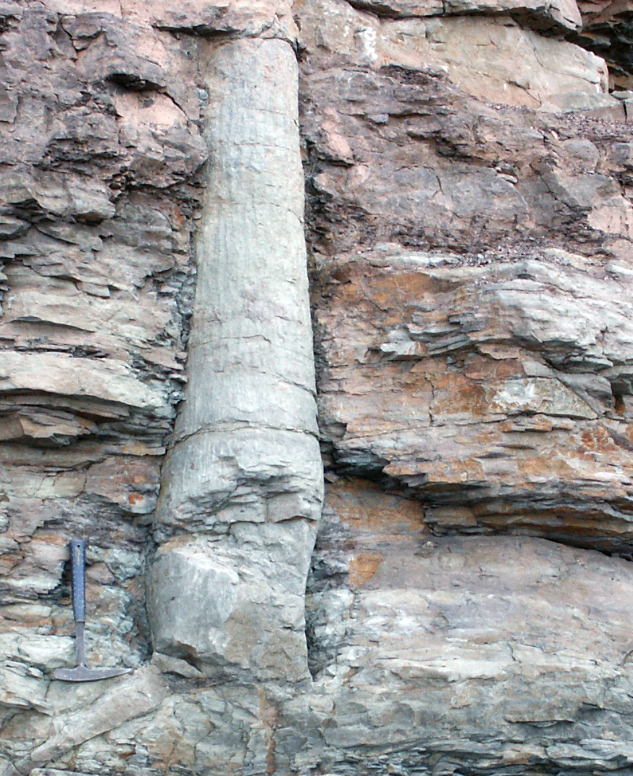 - Yellowstone's petrified polystrate forest (with the NPS exhibit sign removed; see below) with successive layers of rootless trees demonstrating the rapid deposition of dozens layers of strata.
- Yellowstone's petrified polystrate forest (with the NPS exhibit sign removed; see below) with successive layers of rootless trees demonstrating the rapid deposition of dozens layers of strata.
- A similarly formed polystrate fossil forest in France demonstrating the rapid deposition of a dozen strata.
- In many locations, polystrate fossils such as trees span many strata, including famously in the Fossil Cliffs of Joggins, Nova Scotia, which expose sections of 14,000 vertical feet of sedimentary strata, with 49 out of 50 such trees completely lacking their roots, or containing truncated roots, or roots with their rootlets lopped off, indicating that all of these trees were growing elsewhere and transported here in floodwaters.
- These trees lack erosion: Not only should such fossils, generally speaking, not even exist, but polystrates including trees typically show no evidence of erosion increasing with height. All of this powerfully disproves the claim that the layers were deposited slowly over thousands or even a million years. In the experience of your RSR radio hosts, evolutionists commonly respond to this hard evidence with mocking. See also articles in ICR Impact and at CRSQ.
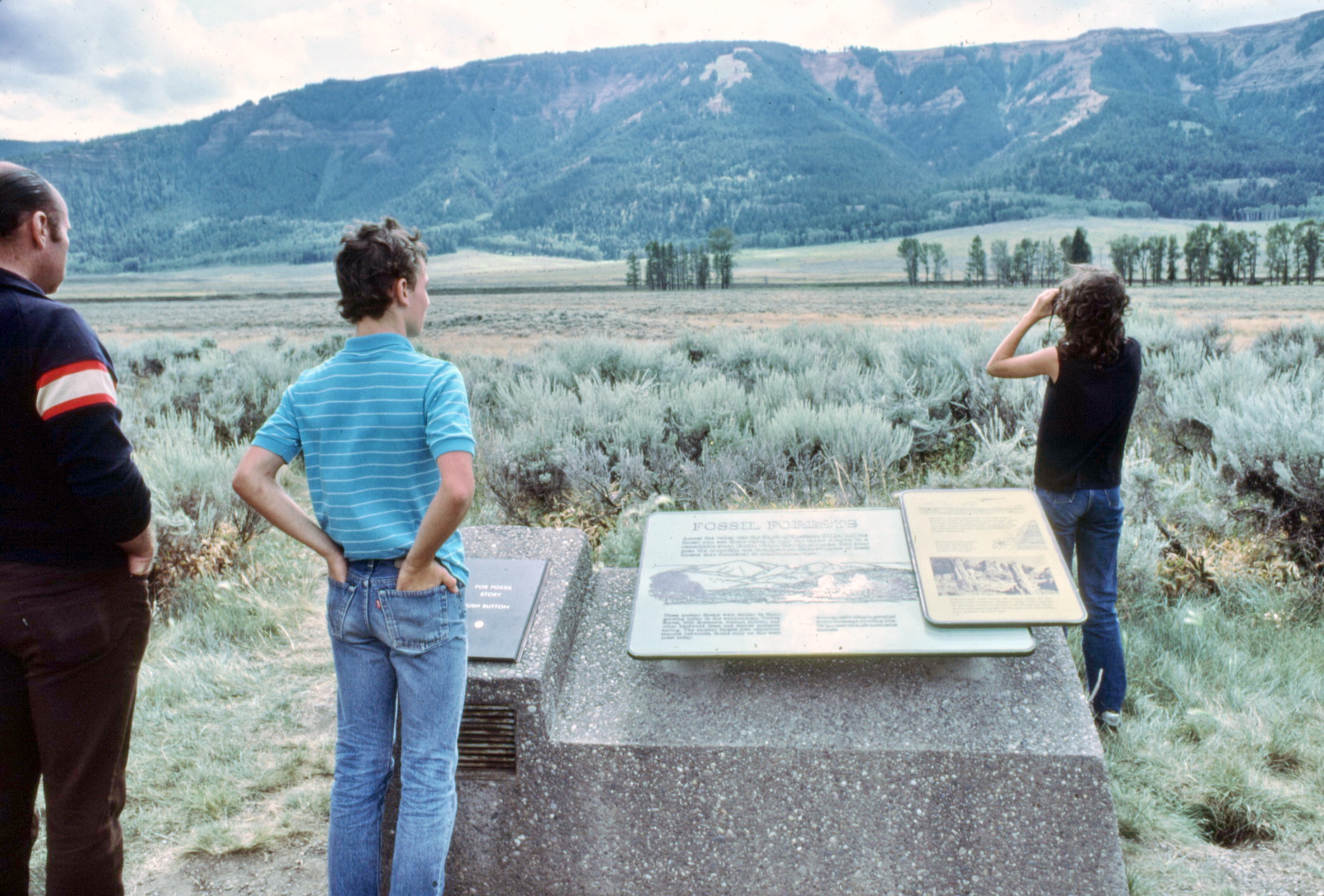 * Yellowstone Exhibit: David Coppedge took these photographs in 1983 in Yellowstone National Park and confirmed to RSR after his 2015 trip that today there are no such signs at Specimen Ridge. Instead, wildlife, etc., exhibits are currently on display there. And near Roosevelt Junction at the fenced-in petrified tree site, the park service presents a sign attributing these tree remains to catastrophic mudflow, which explanation is much closer to reality than their old "successive forests" story. The old, incorrect "Fossil Forest" exhibit claimed that dozens of layers of petrified trees were still standing "where they grew". As explained on Real Science Radio's List of Not So Old Things program, these trees have no root system and were hydraulically transported to their current location. See rsr.org/list#yellowstone. [The second photo below is an RSR composite.]
* Yellowstone Exhibit: David Coppedge took these photographs in 1983 in Yellowstone National Park and confirmed to RSR after his 2015 trip that today there are no such signs at Specimen Ridge. Instead, wildlife, etc., exhibits are currently on display there. And near Roosevelt Junction at the fenced-in petrified tree site, the park service presents a sign attributing these tree remains to catastrophic mudflow, which explanation is much closer to reality than their old "successive forests" story. The old, incorrect "Fossil Forest" exhibit claimed that dozens of layers of petrified trees were still standing "where they grew". As explained on Real Science Radio's List of Not So Old Things program, these trees have no root system and were hydraulically transported to their current location. See rsr.org/list#yellowstone. [The second photo below is an RSR composite.]
After Bob Enyart's Trading Genesis theistic evolution presentation (see it below) in May 2015 in Malibu, California on the Pepperdine University campus, David Coppedge wrote to Bob Enyart at Real Science Radio:
"The book Roadside Geology of the Yellowstone Country by [geology professor] William J. Fritz (1985, 6th printing 1994), on pp 25-26, also talks about the change. He says, 'When I visited the Mount St. Helens area shortly after the eruption, it was just like Yellowstone!.... Both the mudflows and the appearance of the trees is identical.' (p. 25). On page 26, though, he points out differences between the two sites. Nice to meet you in person today [Bob]."
* 1891 Drawing of Similar Polystrate Trees in France: From Hermann Credner's text Elemente der Geologie, page 479 on the "Upright trunks in carbon sandstone of St. Etienne in France". (Click image to enlarge.)

* These Trees Did Not Grow Here: The old-earth biased National Park Service cannot be trusted when it contradicts biblical chronology. For example, creationists worked to correct the NPS' false claim that Yellowstone's petrified trees grew in up to 50 successive forests, each leaving behind one or more individual trees which became petrified, all of this at Specimen Ridge (and Creek).
* Collectively, they form a Polystrate Fossil Forest: Creationists have worked hard to correct the historical record. Yellowstone's petrified trees lack root systems. So, they do not stand where they grew. Instead, they were all deposited during a catastrophic event that was rapidly laying down wet sediments (which lithified into today's strata). These trees, after getting waterlogged and sinking vertically (upright floaters), settled onto what was, at their moment of settling, the topmost layer. They were then soon buried (in days to months; not millennia) by subsequently deposited sediments, and joined by other trees vertically sinking and settling into the successive layers of sediments that were burying the trees that had sunk just days and weeks previously. Thus, the entire system of the fossil forest forms a single polystrate fossil that compresses the formation event from allegedly tens of thousands of years down to mere months. See this also in RSR's 3-minute YouTube video:

 * Example of Polystrate Radiating Spines: (Click on image to enlarge.) These fossils too, like all polystrates, collapse the possible deposition times of various strata, from alleged hundreds or thousands of years or more down to typically minutes and hours. Have you ever wondered how far polystrate-time-compressed strata extend? (If you haven't, you're either new to geology or your lack of scientific curiosity on this suggests that your are a biased old-earth geologist uninterested in the very anomalies that could improve your entire field.) One way to find out how far such rapidly-deposited strata extend is to implement RSR's Geo Earth Explorer tool using the APIs in Google Maps as described at rsr.org/gee and on National Geographic's website and in the CRS Quarterly.
* Example of Polystrate Radiating Spines: (Click on image to enlarge.) These fossils too, like all polystrates, collapse the possible deposition times of various strata, from alleged hundreds or thousands of years or more down to typically minutes and hours. Have you ever wondered how far polystrate-time-compressed strata extend? (If you haven't, you're either new to geology or your lack of scientific curiosity on this suggests that your are a biased old-earth geologist uninterested in the very anomalies that could improve your entire field.) One way to find out how far such rapidly-deposited strata extend is to implement RSR's Geo Earth Explorer tool using the APIs in Google Maps as described at rsr.org/gee and on National Geographic's website and in the CRS Quarterly.
* Example of Limestone Encased Trilobites: This specimen, meticulously restored by FOSSILERA, like countless trilobites around the world, was buried in limestone, much of which is said to be deposited very slowly, grain by single grain of calcium carbonate.

Yet thousands of trilobites from countless locations are buried three-dimensionally, 3D, in other words, not flattened like a piece of paper, but having significant thickness that in polystrate fossils spans layers allegedly laid down sequentially over long periods of time. After having viewed perhaps thousands of trilobites from museum collections, private collections, fossil stores, and over the Internet, it appears that there is no evidence of greater erosion of their upper parts as compared to their lower parts. These creatures, regardless of how many layers of fine particles cover their bodies, were buried in a single depositional event, and not gradually. (See RememberTheNautiloids.com for another enormously widespread example of this observation.)
* Example Polystrate Fossil (this one of a Mesosaur): Here's an example of a polystrate fossil from the collection of the Creation Guy John Mackay. Fossils like this mesosaur, an extinct reptile, buried in multiple "varve" layers, which are claimed to be annual depositions, show no erosional patterns that would indicate a gradual burial. The image to the right, and also from John Mackay (used by permission) is of a bone of an extinct vertebrate squid-like creature, a Belemnite. It's a polystrate fossil because like the countless trilobites, nautiloids, and other creatures, it was buried in limestone, much of which was allegedly super slowly deposited.

* Examples of Typical Timeline Collapsing Polystrate Trees:



* Video of Similar Polystrate Trees in Tennessee: By RSR friend David Rives. (Click image to enlarge, and check this out too.)
* An Entire School of Fish in a Limestone/Shale Deposit: When a fossil of an entire school of fish is found in a finely layered deposit, the entire collection forms a single polystrate fossil which disproves any claim of slow deposition. However, indicating the common presumption to the contrary, a paper at USGS.gov states, "If the Chattanooga shale represents the sediment deposited through millions of years... then each foot of shale represents, on the average, about 150,000 years. These figures, of course, have little quantitative value except to indicate an extremely slow rate of deposition." Actually, they're not even valuable for that! But then again, the authors write that if shale laminae are varves, one foot would represent "only about 300 years," but in an example of circular reasoning, this is "out of harmony with the evidence, largely paleontologic..."

The species, Erismatopterus levatus, appears to be an allegedly extinct trout-perch. RSR's Bob Enyart studied computer science at Arizona State University (entry level through to coursework in AI) and so notices when ASU researchers make important observations, as here.
They charted the position and heading direction of every single fish. Mizumoto found that if he looked at where the fish were and where they were going, they seemed to obey two rules that live, modern fish schools follow: repulsion from close neighbors (as if to avoid bumping into each other) but attraction to more distant fish (as if to stay together as a school). Their positions didn’t appear to be random.
- Nautiloid fossils in the bottom layer of the Redwall Limestone: The Grand Canyon contains millions of dead nautiloids, some as long as your forearm. On average, for every four square meters, one nautiloid either lies or stands upright in limestone throughout the park and far beyond. We've long encouraged old-earthers (like with Stephen Meyer on RSR) to keep an eye out for these fossils.
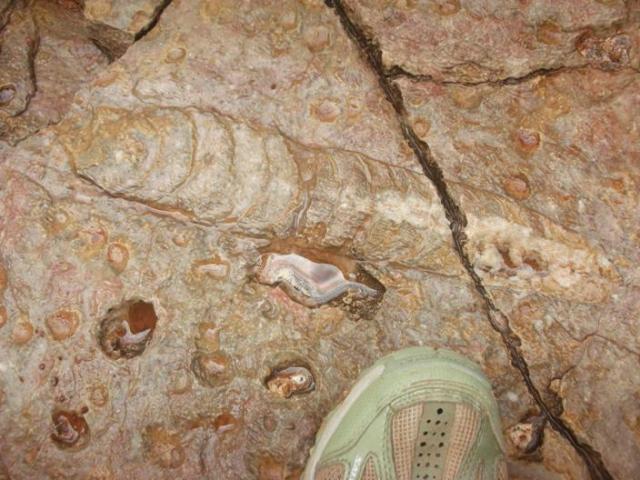
In the Grand Canyon, this basal layer of the Redwall Limestone runs for 277 miles averaging seven feet thick in the east and thickening to about 40 feet as it runs to the west (and beyond, even to Las Vegas). The remains of these creatures distributed over thousands of square miles contradict the standard account for the super-slow formation of limestone. The Redwall allegedly forms at a rate of about 4,000 years per inch. Along with many other dead creatures in this one particular deposit, 15% of these nautiloids were killed and then fossilized standing on their heads. Yes, vertically. Whatever conditions existed at their demise prevented gravity from enabling all of their dead carcasses to fall over on their sides. Of course, these dead creatures would not lay around for 10,000 years on a seafloor waiting to be fossilized, and they certainly wouldn't stand vertically for 80,000 years waiting for the limestone to entomb them. And as seen characteristically at rsr.org/polystrates with even delicate radiating spines and schools of jellyfish permineralized through multiple strata, there is no wear pattern showing greater erosion on the top as compared to the bottom of buried nautiloids and all such fossils, yet again disproving any slow deposition hypothesis. Famed Mount St. Helen's geologist Steve Austin is also the world's leading expert on nautiloid fossils. (See for example Austin's abstract for a Geological Society of America conference titled the Canyon-Length Mass Kill of Orthocone, Nautiloids, Redwall Limestone (Mississippian), Grand Canyon, Arizona which is excerpted at youngearth.com/grand-canyon-nautiloids.) Dr. Austin has worked in the canyon and presented his findings to the park's rangers at the invitation of National Park Service officials. Austin points out, as is true of many of the world's mass fossil graveyards, that this enormous nautiloid deposition provides indisputable proof of the extremely rapid formation of this significant layer of limestone near the bottom of the canyon.
Standard geology teaches students that limestone as at the Grand Canyon forms at the bottom of a shallow and placid sea with slow and gradual sedimentation, often just one grain of calcium carbonate at a time. But a million nautiloids, literally standing on their heads, would beg to differ.
* More Areas of Polystrate Interest: As an exercise for the student, figure out burial rates and other standard explanation challenges for the following:
- "The 90 metres of deposit" of the Hell Creek formation "was created in about 2 million years" yet it is filled with three dimensional hadrosaur fossils (which, by the way, happened to be loaded with original biological material)!
- The pterosaur (and two fish) fossil (and others) in the Solnhofen Limestone deposit in Germany.
And see if you can confirm or falsify the mid-20th century belief that:
- "Polystrate trees are found only in the coarse-grained rocks, but not in the fine-grained ones."
And see curved strata from around the world that makes the same case as polystrates, since multiple strata must be soft and mealable at the same time!
This page is still in draft form. Feel free to send suggestions to Bob@rsr.org. Also, RSR presents some of the above polystrate examples at youngearth.com.
* Bob Enyart's Argument Against Theistic Evolution: as filmed on the Pepperdine University campus at Malibu...

